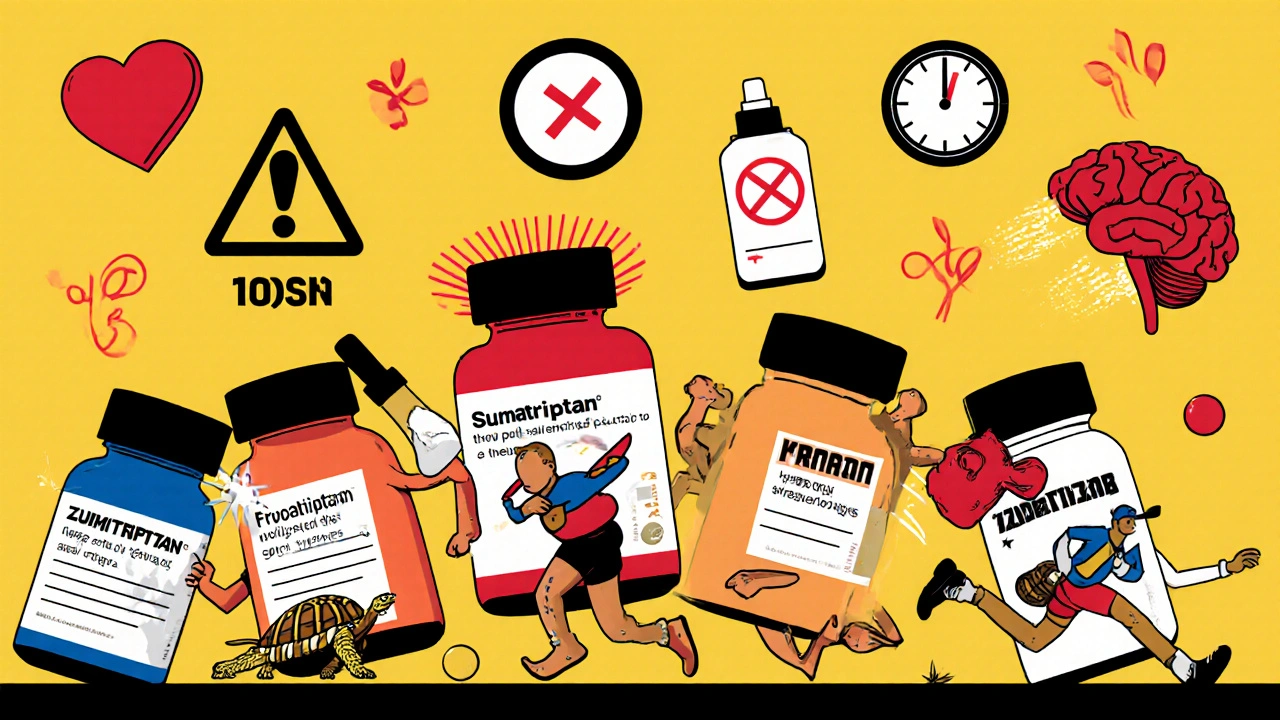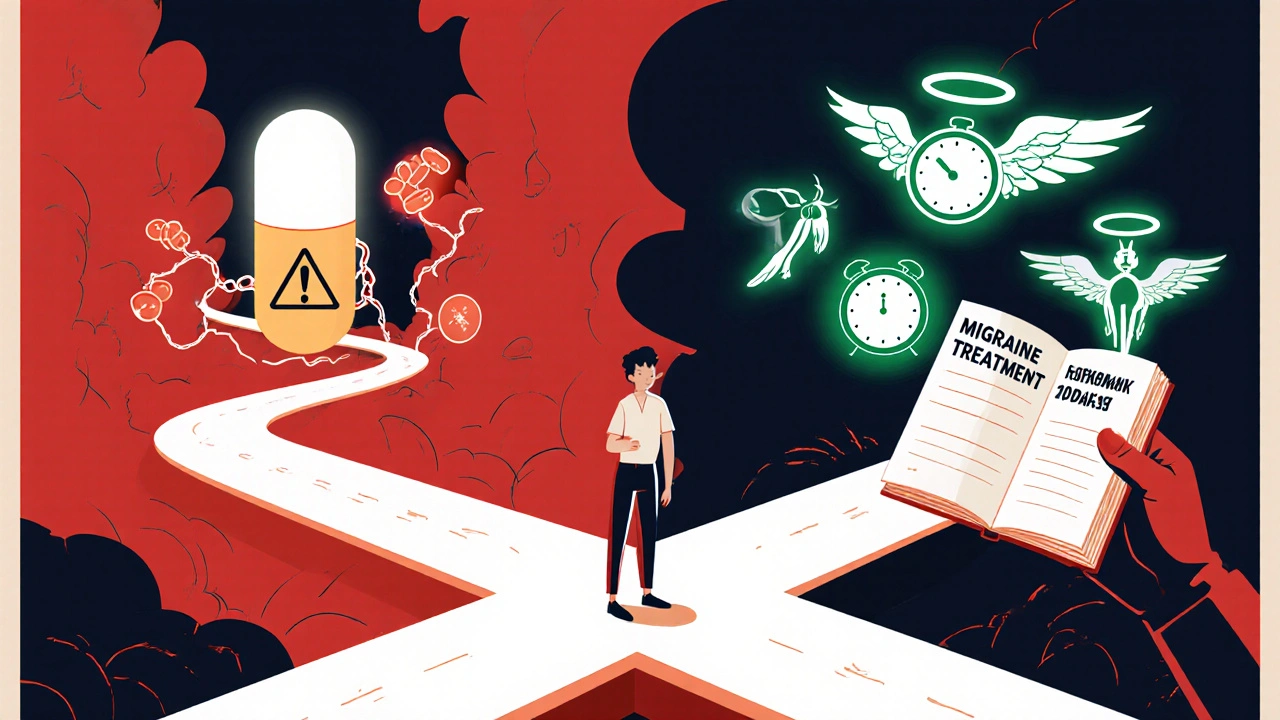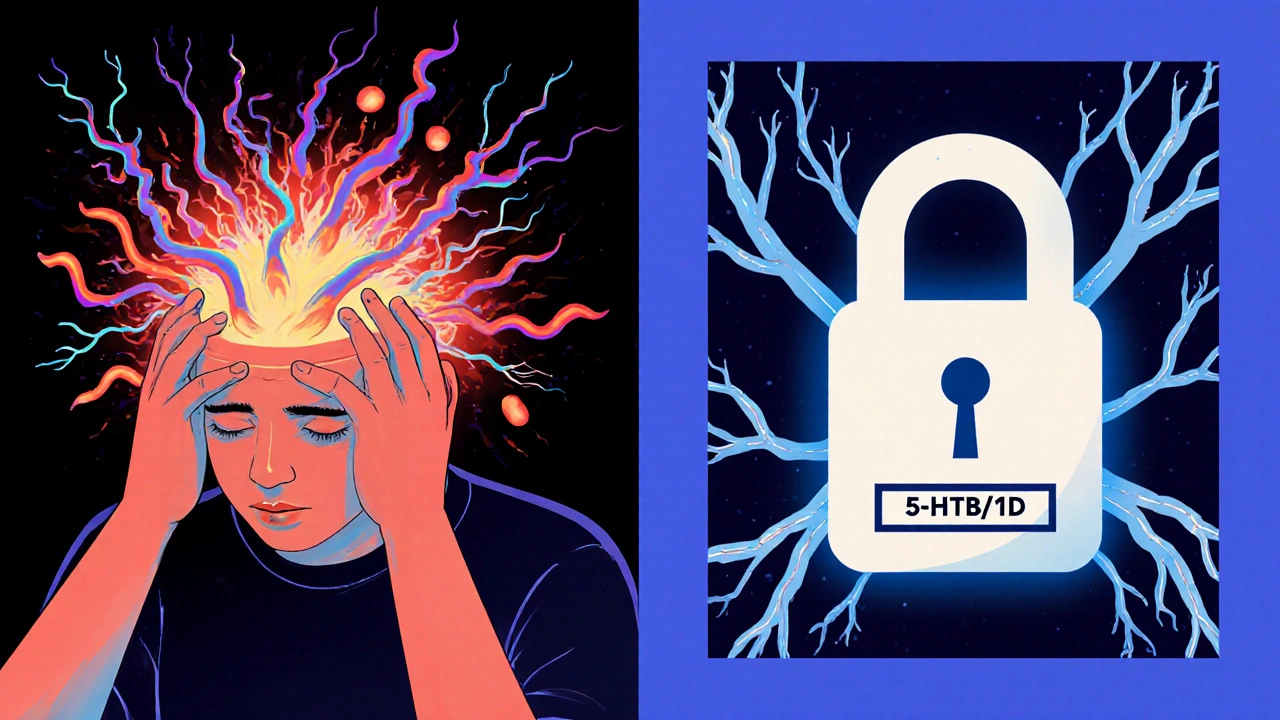Triptan Selection Tool
Assess Your Situation
Answer a few questions to identify triptans that may work best for you.
Your Results
Important Note: This tool provides general information only. Always consult your doctor before starting or changing migraine treatment.
When a migraine hits, time matters. The sooner you treat it, the better your chances of stopping it. For millions of people, triptans are the go-to solution-fast, targeted, and backed by decades of use. But they’re not magic pills. They come with real risks, tricky interactions, and limits that many patients-and even some doctors-don’t fully understand.
What Triptans Actually Do
Triptans aren’t just painkillers. They’re designed to reverse the biological chaos behind a migraine. When a migraine starts, nerves around your brain release chemicals like CGRP and substance P, causing blood vessels to swell and inflammation to flare. Triptans, like sumatriptan, rizatriptan, and zolmitriptan, lock onto 5-HT1B and 5-HT1D receptors. This tightens those swollen blood vessels and shuts down the nerve signals causing the pain.
It’s not guesswork. Studies show that within two hours, 42% to 76% of people get meaningful relief. About 18% to 50% become completely pain-free. That’s why guidelines from the American Academy of Family Physicians and the International Headache Society still put triptans at the top of the list for moderate to severe migraines-especially when OTC pain relievers like ibuprofen or acetaminophen don’t cut it.
The Seven Triptans and How They Differ
Not all triptans are the same. There are seven FDA-approved versions, and each has a different profile. Think of them like different keys for the same lock-some fit better than others.
- Sumatriptan (Imitrex): The original. Fast-acting but short-lived. Half-life: 2 hours. Oral bioavailability: just 14-15%.
- Rizatriptan (Maxalt): Better absorbed-40-45% bioavailability. Often works faster. One of the most effective at the two-hour mark.
- Zolmitriptan (Zomig): 49% bioavailability. Available as a nasal spray and dissolving tablet for faster relief.
- Naratriptan (Amerge): Slower to kick in but lasts longer. Half-life: 6 hours. Good for people who get recurring headaches.
- Frovatriptan (Frova): Longest half-life-26 hours. Used for menstrual migraines or when you need all-day coverage.
- Almotriptan (Axert) and Eletriptan (Relpax): Middle-ground options. Eletriptan has the highest reported two-hour relief rate at 75.3%.
Why does this matter? If one triptan doesn’t work, switching to another might. Around 30-40% of people who don’t respond to one triptan find relief with a different one. It’s not about being “resistant”-it’s about finding the right match for your biology.
When Triptans Won’t Work (And Why)
One in five migraine sufferers gets no relief from any triptan. That’s not rare. And it’s not their fault.
One big reason? Timing. Triptans work best when taken at the first sign of pain-not during the aura, not when you’re already throbbing. Taking them too early, during aura, can make things worse. That’s because blood vessels are already constricted during aura. Triptans tighten them further, potentially worsening neurological symptoms.
Another major factor: cutaneous allodynia. That’s when your skin becomes painfully sensitive-light touch hurts. If you can’t brush your hair or wear a shirt without flinching, triptans are far less likely to help. Studies show effectiveness drops from 70-80% in people without allodynia to just 30-40% when it’s present. This signals that the migraine has progressed beyond the vascular phase into central sensitization. At that point, other treatments-like gepants or ditans-might be better options.
Serious Interactions You Can’t Ignore
Triptans are generally safe-but they play rough with certain drugs.
The biggest red flag: SSRIs and SNRIs. These antidepressants (like sertraline, fluoxetine, venlafaxine) raise serotonin levels. Triptans also stimulate serotonin receptors. Combine them, and you risk serotonin syndrome-a rare but dangerous condition. Symptoms include confusion, rapid heart rate, high blood pressure, muscle rigidity, and fever. It’s not common, but it’s real. The FDA warns against using triptans with MAO inhibitors entirely. With SSRIs/SNRIs, use caution. Don’t double up unless under close supervision.
Another dangerous combo: ergotamines (like Cafergot or Migranal). These are older migraine drugs that also constrict blood vessels. Using them with triptans-even hours apart-can cause severe, life-threatening vasoconstriction. Guidelines say to wait at least 24 hours between doses. Many doctors avoid prescribing both altogether.
Even NSAIDs can interact. While combining sumatriptan with naproxen (as in Treximet) is approved and effective, mixing other triptans with NSAIDs isn’t always studied. Stick to what’s labeled unless your doctor says otherwise.

Who Should Never Take Triptans
Triptans are not for everyone. They’re absolutely contraindicated if you have:
- History of heart attack or angina
- Coronary artery disease or vasospasm
- Stroke or transient ischemic attack (TIA)
- Uncontrolled high blood pressure
- Peripheral artery disease
- Severe liver damage
Even if you’ve never had symptoms, if you’re over 40 and have risk factors-smoking, diabetes, high cholesterol-you should get checked before starting a triptan. A 2006 study found that for every 10,000 people taking sumatriptan for a year, 0.08 had a heart attack. That’s rare-but it’s not zero. And it’s preventable with screening.
Dosing Limits and Overuse Risks
Triptans are powerful, but they’re not meant for daily use.
The International Headache Society says: no more than two doses of any triptan in 24 hours. And you need at least two hours between doses. Exceed that, and you risk medication-overuse headache (MOH)-a cycle where the medicine you take to stop headaches ends up causing them more often.
MOH is sneaky. You might think you’re treating migraines, but you’re actually creating a new problem. About 1 in 4 people with chronic headaches are stuck in this loop. That’s why doctors track how many triptan doses you use per month. If you’re using them more than 10 days a month, it’s time to rethink your plan.
Side Effects: Common, But Not Always Trivial
Most side effects are mild and short-lived:
- Chest or throat tightness (5-7% of users)
- Dizziness (4-10%)
- Fatigue (3-8%)
- Nausea or tingling
But chest tightness? That scares people. It feels like a heart attack. The truth? It’s not cardiac. Triptans cause temporary constriction in the coronary arteries, which can trigger a sensation of pressure. It usually lasts less than 10 minutes. Still, if you’ve never had this before, or if it lasts longer or comes with sweating or shortness of breath, get checked. Better safe than sorry.

What’s Next? Beyond Triptans
Triptans have dominated migraine treatment for over 30 years. But the landscape is shifting.
Newer drugs-gepants (like ubrogepant and rimegepant) and ditans (like lasmiditan)-don’t constrict blood vessels. That makes them safer for people with heart disease. Gepants also work well for people who don’t respond to triptans. In clinical trials, they match triptan efficacy without the cardiovascular risks.
Meanwhile, combination therapies are gaining traction. Treximet (sumatriptan + naproxen) gives better results than either drug alone. The 2-hour pain-free rate jumps from 18% with sumatriptan to 27% with the combo.
Triptans aren’t going away. They’re still the most studied, most affordable, and most widely prescribed acute migraine treatment. But for patients with contraindications, frequent use, or poor response, the alternatives are no longer experimental-they’re essential.
What to Do If Triptans Aren’t Working
If you’ve tried one or two triptans and nothing changed:
- Check your timing. Are you taking it at the first sign of pain-not aura, not after it’s already pounding?
- Try a different formulation. If you’re on pills, switch to nasal spray or dissolving tablets. Faster absorption = better results.
- Switch triptans. Don’t give up after one failure. 30-40% of non-responders to one triptan respond to another.
- Rule out allodynia. If your skin hurts when you touch it, triptans are less likely to help. Talk to your doctor about gepants or ditans.
- Track your usage. Are you hitting the 10-day-a-month limit? If so, you might be causing rebound headaches.
- Consider a preventive. If you’re using triptans more than twice a week, you might need a daily preventive medication to reduce attack frequency.
There’s no single answer. Migraine is personal. What works for your neighbor might not work for you. But with the right approach-timing, dosage, switching, and knowing your limits-you can find relief.
Can I take a triptan with ibuprofen?
Yes, but only if it’s a combination product like Treximet (sumatriptan + naproxen). Mixing other triptans with ibuprofen isn’t well studied and could increase side effects. Stick to approved combos unless your doctor advises otherwise.
Do triptans cause addiction?
No, triptans aren’t addictive like opioids or benzodiazepines. But they can cause medication-overuse headache if used too often-more than 10 days a month. That’s not addiction; it’s a physiological rebound effect.
Why does my chest feel tight after taking a triptan?
Triptans cause temporary constriction of blood vessels, including those in the chest. This can feel like pressure or tightness, sometimes mimicking a heart attack. It’s usually harmless and lasts less than 10 minutes. But if you’re unsure, or if it’s accompanied by sweating, nausea, or shortness of breath, seek medical help immediately.
Are triptans safe if I have high blood pressure?
Only if your blood pressure is well-controlled. Triptans can raise blood pressure temporarily. If you have uncontrolled hypertension, they’re not safe. Always check your BP before taking a triptan if you have a history of high blood pressure.
What’s the best triptan for fast relief?
Rizatriptan (Maxalt) and zolmitriptan (Zomig) nasal spray or dissolving tablets tend to work fastest. Rizatriptan has higher bioavailability and often provides relief in under an hour. But effectiveness varies by person-what’s fastest for one person may not be for another.
Can I take a triptan during my migraine aura?
No. Triptans should be taken at the start of head pain, not during aura. During aura, blood vessels are already constricted. Taking a vasoconstrictor then may worsen neurological symptoms. Wait until the pain begins.
Why do some people need to try multiple triptans?
Because migraine is biologically complex. Different triptans bind to serotonin receptors with slightly different strengths and speeds. One might work for your vascular response but not your nerve signaling. Switching gives you a better chance of finding the right fit-about 30-40% of people who fail one triptan respond to another.
Final Thoughts
Triptans are powerful tools-but they’re not one-size-fits-all. They require timing, awareness of your body, and respect for their limits. If you’ve been struggling with migraines and triptans haven’t helped, don’t assume you’re out of options. You might just need the right one, the right dose, or the right timing. Talk to your doctor. Track your attacks. And remember: what works today might not work tomorrow. Migraine treatment is a journey, not a fix.


Halona Patrick Shaw
November 1, 2025 AT 08:29Man, I’ve been on this ride for 12 years. Tried every triptan under the sun. Sumatriptan made me feel like my chest was being squeezed by a dragon. Zolmitriptan nasal spray? Magic. Felt like someone flipped a switch in my brain. No more lying in a dark room for 18 hours. Just… gone. Still can’t take it with my SSRIs though-doc scared me straight on that one.
Also, the aura thing? Real. Tried it once during the zigzag lights. Woke up with a headache that felt like my skull was splitting. Never again. Wait for the pain. Patience, grasshopper.
Elizabeth Nikole
November 2, 2025 AT 01:30Triptans are just Big Pharma’s way of keeping us hooked while they ignore the real cause: electromagnetic pollution from 5G towers and glyphosate in your kale smoothie. You think your headache’s from serotonin? Nah. It’s from the wifi in your toaster. I’ve stopped all meds. Now I just wear a copper hat and chant at the moon. Works better than any pill.
Also, your doctor’s lying to you. They get kickbacks from pharma. Wake up.
Terri-Anne Whitehouse
November 2, 2025 AT 07:06Let’s be honest-most people don’t even know what ‘cutaneous allodynia’ means. You’re telling me someone with a migraine can’t wear a shirt? That’s not a headache, that’s a full-body sensory meltdown. And yet, half the docs I’ve seen still treat it like a ‘bad tension headache.’
And don’t get me started on the ‘try another triptan’ advice. It’s like being told to try a different key when the lock’s been jammed with superglue. If your nervous system’s already in full panic mode, throwing more vasoconstrictors at it is like pouring gasoline on a fire.
Also, the fact that Treximet works better than sumatriptan alone? That’s not a combo-it’s a revelation. Naproxen isn’t just a helper, it’s the silent partner in crime. Why isn’t this standard protocol?
And yes, I’ve hit the 10-day limit. I know what MOH is. I’m not stupid. I’m just trapped. And no, I don’t want to hear about ‘preventives.’ I’ve tried amitriptyline. It turned me into a zombie who cried during commercials for dog food.
Amy Craine
November 2, 2025 AT 21:18Thank you for writing this with so much clarity. I’ve been struggling for years, and this is the first time I’ve read something that actually made sense.
I tried sumatriptan for years, thought I was just ‘not responding.’ Turns out I was taking it during aura. Then I switched to rizatriptan OD-worked like a charm. And yes, chest tightness? Terrifying the first time. Felt like a boa constrictor. But my neurologist said it’s not cardiac-just the drug doing its job. I carry a note in my wallet now. ‘If I collapse, I took a triptan. Not a heart attack.’
Also, the gepants? I started ubrogepant last month. No chest feeling. No vasoconstriction. Just… relief. It’s expensive as hell, but my insurance covered it after I begged. Worth every penny.
To anyone reading this: don’t give up. It’s not you. It’s the system. But there are options. You’re not broken.
LeAnn Raschke
November 4, 2025 AT 17:19I’ve been using Frova for menstrual migraines for 5 years. It’s slow, but it lasts. I take it at the first twinge, even if I’m at work. No drama. No panic. Just… calm.
I used to stress about the 10-day limit. Then I started tracking in a simple notes app. Now I know when I’m creeping up. It’s not about guilt-it’s about awareness. I’m not addicted. I’m just smart.
And yes, I tried 4 triptans before Frova worked. Don’t quit after one try. Your body’s unique. Find your match.
Kyle Buck
November 5, 2025 AT 06:58While the pharmacodynamic profiles of triptans are indeed well-characterized, the clinical translation of receptor affinity kinetics (5-HT1B/1D) to individual phenotypic response variability remains underexplored in large-scale real-world datasets.
Furthermore, the conflation of ‘medication-overuse headache’ with ‘addiction’ perpetuates a pathological framing of neurologic self-management. MOH is a maladaptive neuroplasticity phenomenon, not a behavioral dependency. The distinction is critical for therapeutic adherence and stigma reduction.
Additionally, the assertion that ‘gepants lack vasoconstrictive effects’ requires qualification: while they are CGRP antagonists and thus avoid direct smooth muscle contraction, their impact on cerebral hemodynamics in patients with vascular comorbidities remains incompletely mapped in phase IV studies.
Recommendation: Future guidelines should incorporate pharmacogenomic screening (e.g., CYP2D6 metabolizer status) prior to triptan initiation to optimize efficacy and mitigate adverse event risk.
Ram Babu S
November 6, 2025 AT 04:36I live in India. Here, most people don’t even know what a migraine is. They think it’s ‘stress’ or ‘bad thoughts.’ I tried to explain triptans to my uncle-he thought I was talking about a new kind of chai.
But I’ve been using sumatriptan for 8 years. No issues. I take it only when the pain hits. Not before. Not during aura. Just when it’s time. And I never take more than one in a day.
My advice? Listen to your body. Don’t let fear stop you. But don’t be reckless either. Be quiet. Be patient. And talk to a good doctor. Not the one who just writes prescriptions. The one who listens.
Danny Pohflepp
November 6, 2025 AT 07:02Triptans are a scam. The whole migraine industry is built on fear. The ‘vascular theory’? Debunked in 2012. CGRP? A marketing ploy. The FDA approved these drugs because they’re profitable, not because they work. Look at the lawsuits. Look at the adverse event reports. People are dying from ‘chest tightness’ and no one’s talking about it.
And don’t tell me about ‘dosing limits.’ That’s just to keep you buying more. The real solution? A ketogenic diet, infrared sauna, and avoiding fluorescent lighting. That’s what cured me. Not some chemical that tightens your arteries.
They don’t want you to know this. They want you dependent. Wake up.